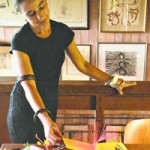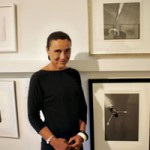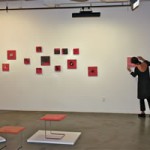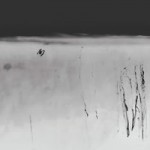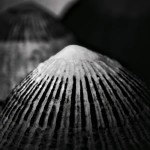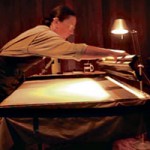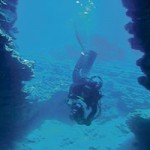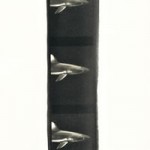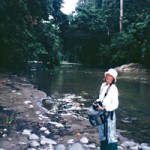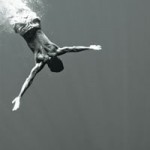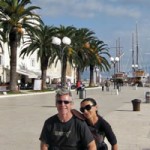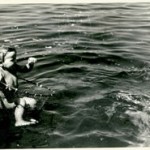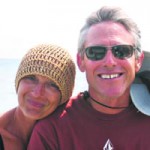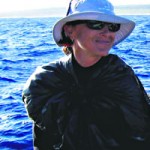An Artful Harbor
Having lived much of her life as an aquatic nomad, Bruna Stude drops anchor on Kaua’i and creates galerie 103 in Poipu, where her monochromatic ocean pieces are turning heads and gaining fans
Kaua’i artist Bruna Stude is a nomad at heart. The only place that has ever felt like home to this wanderlust-ridden curator, photographer and gallery owner is the ocean. Perhaps that’s why Kaua’i became her home in 2003, following more than two decades yachting and circumnavigating the globe as part of a crew.
“I’m a bit of a gypsy,” the Croatian native admits. “Maybe it’s because when I was really little I was sent to school in Italy. But I learned from an early age the beauty of going places and discovering new languages and new cultures.”
Since childhood, Stude has been drawn to the call of the ocean – not the beach or the surf, but being out at sea, which at the time, was the Adriatic.
“I would ask my mom if I could go on the water with the fishermen,” she says. “I wanted to be at sea and see life.”
To this day Stude continues to answer that calling by capturing images of the ocean in a seemingly infinite number of ways, in her signature form of platinum and palladium prints, in a minimal palette of silver, black and white.
“From the spectrum, you start losing color once you’re deep in the water,” Stude says. “So, basically I’m photographing the texture, the light. … I love it. I love anything monochromatic, and have always tried to inspire from and focus on the beauty of the ocean.”
Since Kaua’i isn’t brimming with galleries housing modern and contemporary art, those who seek it out have likely found themselves within Stude’s quaint minimalist space, galerie 103 in Po’ipu. The gallery is home to a broad swath of contemporary artists, including the provocative work of Sally French and Margaret Ezekiel. It’s also chock-full of one-of-a kind and limited-edition furniture, artbooks and odd, eclectic art dolls.
Calling Stude’s work “complex, loose and evocative,” French says one of its salient features is how inviting and open it is to interpretation.
“It doesn’t lend any premise to the viewer,” she says. Calling her colleague “almost amphibian,” French adds that Stude’s work parallels water in many ways, including the sense of openness it conveys.
Water is a study Stude has aimed to capture for decades. At first, the focus was on marine life and the universal human relationship with it, which comes across in one of her most recognizable works, “Pearl Diver.”
“I wanted to photograph native divers to show how seamless these people are with the ocean,” she says. “They see the fish, catch the fish, often without fins. And I always wanted to capture the beauty of it. Finally, in Indonesia, the light was just right, the visibility was clear, and I saw him diving from his canoe and knew it was going to be perfect.”
Though Stude spent years searching the oceans for images teeming with marine life, in 2008 that changed forever.
She was on a shoot in Honduras preparing for a show at Kaua’i Museum. Hoping to photograph whale sharks, which she dubs the “ambassador of all sharks” because of their harmlessness and mammoth beauty, there were none to be found.
“I went to work with a scientist, and for 10 days we went out every day didn’t see one,” she says.
As someone who had traveled the seas for most of her life, Stude had a contextual appreciation for the stark shift in the whale shark population, particularly as it was their migrating period. Attributing the quiet waters to shark-finning, Stude decided to make her installation piece about the whale shark’s lack of existence instead.
“The first day, I had tested my camera and photographed the ocean itself when we didn’t see any whale sharks. The second day, I thought, if we aren’t going to see any, I will photograph the lack of them. Following that, it was day after day shooting empty ocean.”
It was Stude’s hope that her work, which resulted in a series called “Empty Oceans,” would open up the dialogue about creatures on the verge of extinction, as well as the impact humans have on marine life populations.
The series resonated so strongly with viewers that, to this day, Stude doesn’t include marine life in her work.
“I just photograph water and the lack of life in it,” she says. “The reaction, even to the term ’empty ocean,’ is so much stronger than having captured the image of a beautiful fish or talking to people about shark-finning.”
Not a trust-funder by any means (she is closer to the definition of “starving artist” than she is “heiress”), Stude says being part of a boat crew enabled her not only to see the world and what she calls “one ocean,” but also to put enough money away to open her gallery, a space she hopes fosters dialogue on global environmental issues and “other matters shaping human destiny.”
Yachting also enabled Stude and her life partner, Carter Corey, to purchase their first piece of land in Kalaheo, and to build a home.
“I don’t have belongings, but I love to collect art,” Stude says. “That’s my weakness. That’s why we finally had to have a house, for a place to house the art.”
The ocean isn’t all work and no play for Stude, however. Having spent years windsurfing and diving, she’s recently taken up standup paddling. It’s also a vital part of her life because, to her, water is what connects all of us. Using an anecdote about one of the similarities between Kaua’i and her hometown of Split, she talks about ‘opihi, which are called pri lipak in her native Dalmatian language.
“People love to pick (and eat) ‘opihi there, just like here,” she says. It’s not only part of the cuisine, but part of their idiomatic turns of phrase. “Someone who is ‘clingy’ is called an ‘opihi, so it’s used in the same manner as here.
“It’s just another example of something that made me feel connected because it’s grounding and unique,” she adds. “Plus, there aren’t many places you eat ‘opihi.”
As for her nomadic nature, Kaua’i may have cured that.
“This is home. There is something about this island, I just felt at home the first time I was here. It’s in everything,” she says. “Even the scent of it.”
Whenever Stude needs her ocean fix, she submerges herself in the water to hear the whale song.
On Oahu through July 22, she represents Kaua’i as one of the invited artists in the Biennial of Hawai’i Artists X. Following that, her work will be on display at her gallery, and in August at the Shops at Kukui’ula.
- Having spent much of her life in and on the ocean, Bruna Stude drops anchor at galerie 103 in Poipu with an exhibition of evocative images, many inspired by her relationship with the sea. Amanda C. Gregg photo
- Kaua‘i artist Bruna Stude at home, surrounded by art reading a art pop-up book (photo by Linny Morris)
- At galerie 103 (Amanda C. Gregg photo)
- At galerie 103 (Amanda C. Gregg photo)
- Storm,’ one of her pieces at the Biennial of Hawaii Artists X
- ’Opihi’
- The laborious process of platinum printing
- Diving, camera in hand
- ‘Predator.Prey’ platinumpalladium print
- Being a stock photographer is part of how Stude funded her travels. In Sarawak, Borneo
- With dog Brolie at galerie 103 (Amanda C. Gregg photo)
- ‘Pearl Diver’
- Back near home on the Dalmatian Coast in November
- Swimming with her father off the Dalmatian Coast as a child
- With life and travel companion Carter Corey/photo courtesy Bruna Stude
- On a dive trip to Lehua


